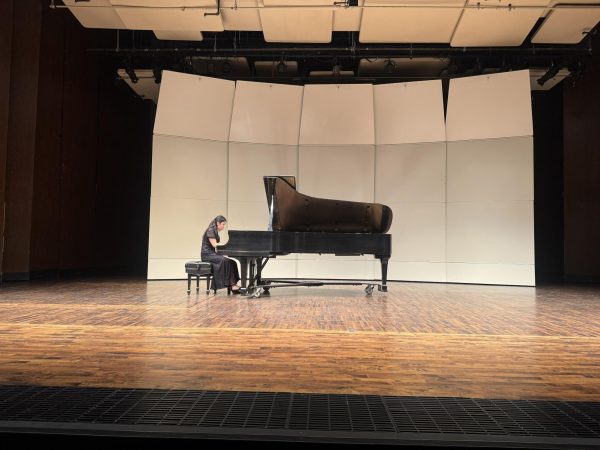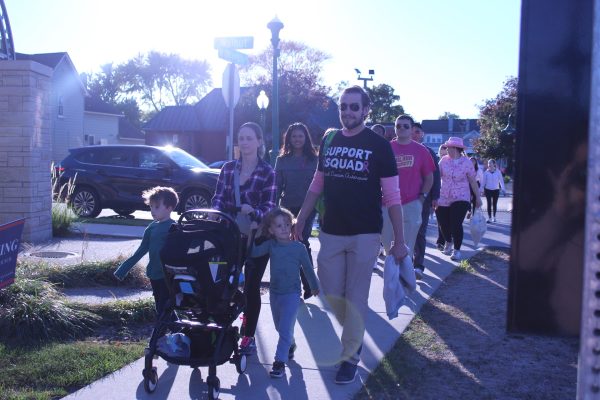Students construct mixed feelings about changes on campus
Construction of the Oakland Center is causing some frustrations, among other controversial changes.
As students returned for the new semester, the campus looked quite different than it did in the spring. Construction crews set up shop along the exterior of the Oakland Center for the next year, and trailers found a home on the lawn in front of Kresge.
The OC is getting revamped
The OC makeover is not the only major change that took place this summer. Several other departments rolled out tweaks of their own.
The OC remodel first broke ground in the beginning of April 2017 and has been a work in progress for the last four months. Bit by bit, the OC shrank as three entrances were blocked off, offices on the first floor were scattered across available rooms on the main level and a majority of the organizations that inhabited the basement were relocated to trailers.
To accommodate students as they made their way around campus, temporary sidewalks were constructed, and the entrance near the temporary ID office became one of two remaining main entrances to the OC.
“I feel like the construction has limited the students in the OC given the fact that there’s so many of us, and now it’s half the size it used to be,” senior Samuel Hannouche said. “It can also get really frustrating having to walk all the way around the building, but the new building is going to be really nice when it’s done.”
Parking is… better?
Included in the summer construction, an additional 726 spots were added to campus along with a new roundabout at Pioneer Drive and Meadow Brook rd. But, some students still feel that parking is a nightmare.
“I think the roundabouts help with traffic. However, parking is still atrocious. They put spots in areas that didn’t necessarily need it in my opinion. There should be more spots near the OC and dorms so people don’t have to walk so far,” Hannouche said.
Course renumbering: all three-digit numbered courses are now four numbers
Around the same time the remodel of the OC was announced last year, the Office of the Registrar implemented the course renumbering project that moved from three-digit course numbers to four-digit numbers. This project was due to the university not having anymore available three-digit course numbers.
“The new numbering policy expands the range of numbers used for course numbering and provides academic units the opportunity to re-align their curriculum with the new four-digit numbering scheme,” Registrar Steve Shablin said. “I believe overall this has been a successful initiative. We sent a number of communications to students, faculty and staff informing them of the change prior to full-year registration and throughout the summer.”
Student Financial Services payments
One of the most abrupt changes comes out of the office of Student Financial Services. For the 2017-18 academic year, tuition payment is due three weeks before semester classes begin. Student Financial Services outlined the change in due dates was initiated to help reduce outstanding debt and limit late penalties as well as free up available housing and classroom space. Students that do not pay their eBill by the listed date or enroll in a payment plan will be dropped from classes and removed from housing. This means students that pay with federal and private loans must begin requesting funds much earlier than last year.
“Normally I would pay my bill when school started, but since my dad isn’t great with technology and is busy most of the time, it was way more stressful to get the loans taken out in time” Hannouche said. “I think if the due date must stay the same, then we shouldn’t get kicked out of classes immediately.”
Housing changes
While individual departments focused primarily on single changes, housing developed a series of new initiatives for its residence. The biggest of these changes come from the meal plans, which directly affect majority of people living on campus. Early stages of new meal plans were proposed in late January. The new meal plans featured an increase in declining dollars, but transfer meals were no longer an option. These plans went into effect for the 2017-18 year as new, incoming students no longer had a choice of the traditional plans that offered transfer meals.
“As someone who chose the new meal plan, I think the new meal plans aren’t necessarily better or worse,” sophomore resident Shelby Hanselman said. “I think that transfer meals were great. If I could right now, I would switch back to the old meal plans.”
In the beginning of September when students moved into residential facilities, they learned of two more recent plans to better the housing community. The first was the “new no command strip” rule. Students were given putty to hanging up items on the wall to reduce damage to the drywall.
“I think that the no command hooks rule is kind of unfair,” Hanselman said. “Most students weren’t even informed about it until they had already put command hooks on the wall. They are necessary for a room. You can’t use putty to do everything.”
The second plan was the new eco-container carryout program. Chartwells and the Vandenberg Dining Center have replaced styrofoam and paper containers with plastic, reusable containers. Once residents have filled the container and are done with it, they need to rinse it and return it to the dining hall.
“I think the new to go boxes are a good idea in the long term sense, but at the same time I think it’s kind of much,” Hanselman said. It just adds a bit of inconvenience to students now having to always remember to bring their box back.”
A lot of change is being done on campus right now, but Oakland is a growing campus expanding to meet the needs of its students and the environment. As of right now, the date for the end of the OC renovation is set for Fall 2018.





